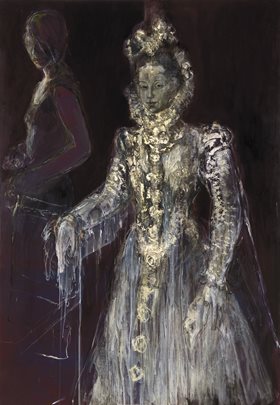.aspx) PhD offers ‘a landscape of possibilities…’
PhD offers ‘a landscape of possibilities…’
Angela Stewart by Louise Morrison
Angela Stewart’s career features almost three decades of teaching art students as well as several intensive bouts of being one. Apart from the Graphic Design course she commenced after high school and quickly abandoned, Angela’s first experience as an art student was in the mid-1980s at Curtin University where she attained her Bachelor of Arts (Fine Art). She began teaching there as a sessional Lecturer not long after graduating and continued to do so for a number of years whilst she established her art practice.
Angela consolidated her interest in portraiture during this time and, in 1992, entered the Masters in Fine Art program at Curtin University to more thoroughly investigate the history of portraiture and its contemporary practice. Once again, shortly after graduating, Angela accepted an offer of teaching work, this time as a Lecturer at Claremont School of Art (a position that she still holds at Central Institute of Technology).
A decade later, having worked in arts education for 16 years and with both Bachelor and Masters degrees, Angela commenced her studies towards the qualification of Doctor in Creative Practice. It’s tempting to wonder why. In her case, it was not required to secure employment and, on more than one occasion, others shared their opinion that “you don’t need a PhD to be an artist”. This is a common view and, in fact, some oppose the academizing of art. The concern that PhD programs in particular subject the exploratory processes of art-making to a scientific model of enquiry is probably best summarized by the statement that “it makes art into a hothouse flower"1.
 At the time, Angela agreed that no one needs a PhD to be an artist. She simply thought that since she was already in the process of producing a significant body of work, she might as well be paid to do it. Indeed, many artists view the potential PhD scholarship as an income source that is as reasonable and reliable as any other employment opportunity that artists secure. While acknowledging that the additional income was the primary incentive, in hindsight, Angela observes that the unexpected benefits of completing her PhD far outweighed the financial boon.
At the time, Angela agreed that no one needs a PhD to be an artist. She simply thought that since she was already in the process of producing a significant body of work, she might as well be paid to do it. Indeed, many artists view the potential PhD scholarship as an income source that is as reasonable and reliable as any other employment opportunity that artists secure. While acknowledging that the additional income was the primary incentive, in hindsight, Angela observes that the unexpected benefits of completing her PhD far outweighed the financial boon.
In the course of her six year investigation, Angela identified an area of particular interest in portraiture, that of ‘artistic doubt’, and she produced a series of paintings in response to this and to the work of a sixteenth century portrait painter called Sofonisba Anguissola. The paintings are significantly different to Angela’s previous work; resolution has given way to a celebration of doubt, materiality and process.
The other outcome of the intensive study period was a collection of Angela’s creative writing that is currently being considered for publication. Angela admits that a written work is something she never anticipated producing but the process of open-ended enquiry that is the nature of PhD level studies and the unforeseeable creative development that results from that process, has proven to be the program’s true reward. As she puts it,
“The unexpected can happen in the course of a PhD."
"I discovered a love of creative writing, not unlike painting where you begin and have no idea where it will take you. I found my curiosity being reinvigorated, research took me into a landscape of possibilities. I arrived back in the end to my original research question with an element of surprise at my findings and profound respect for my muse Sofonisba Anguissola… I loved the journey.”
1 Elkin J. 2008 Artists with PhDs, Debates About the New Studio Doctoral Degree retrieved from http://www.academia.edu/168372/Artists_with_PhDs_On_the_New_Doctoral_Degree_in_Studio_Art_opening, 05/02/13
Louise Morrison is an Artist and a Lecturer at Central Institute of Technology in Perth. She also writes about visual art on a freelance basis with a focus on local, contemporary practise.
This article featured in the Artsource Newsletter, Autumn 2013.